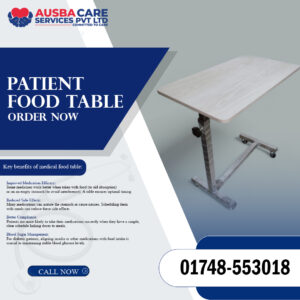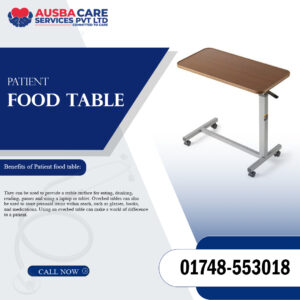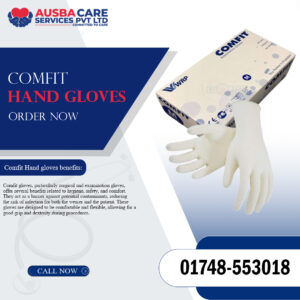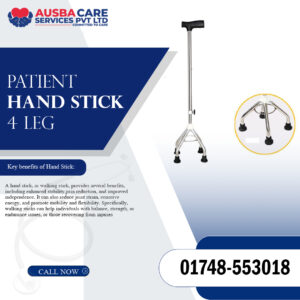Description
Everything You Need to Know About Hand Crutches: Types, Uses, and Best Practices
Hand crutches are essential mobility aids that provide support and stability to individuals with temporary or permanent lower limb injuries, disabilities, or post-operative needs. Whether recovering from surgery, dealing with a leg injury, or managing a chronic condition, hand crutches are critical in helping individuals maintain independence and mobility.
In this article, we’ll explore the types of hand crutches, their benefits, how to use them properly, and tips for selecting the right crutch for your specific needs.
What Are Hand Crutches?
“Hand crutches are mobility devices designed to assist individuals with impaired lower limb function by transferring body weight from the legs to the upper body, allowing for greater mobility and stability during movement.” Unlike canes, which provide balance support, crutches are used to offload weight from the legs entirely or partially. They are commonly prescribed after lower body injuries, fractures, surgeries, or in the management of conditions like arthritis, cerebral palsy, and multiple sclerosis.
Types of Hand Crutches
There are several types of hand crutches, each designed for specific use cases:
1. Axillary Crutches (Underarm Crutches)
They fit under the armpits and have a handgrip partway down the shaft. Weight is supported primarily through the hands, not the armpits, to avoid nerve damage.
Best for: Short-term injuries like fractures or surgeries.
Pros:
-
Easy to use.
-
Widely available.
-
Good for non-weight-bearing conditions.
Cons:
-
It can cause underarm discomfort.
-
Not suitable for long-term use.
2. Forearm Crutches (Lofstrand or Elbow Crutches)
These have a cuff that fits around the forearm and a handle for gripping. They are often used by individuals who require long-term mobility assistance.
Best for: Long-term mobility support, such as in neurological conditions.
Pros:
-
More freedom of movement.
-
Less strain on shoulders.
-
Easier to use on stairs.
Cons:
-
Requires more upper-body strength and coordination.
-
Less stable for those with poor balance.
3. Platform Crutches
These crutches have a horizontal platform where the forearm rests and are strapped in place, with the hand gripping a vertical handle.
Best for: Individuals with weak hand grip, wrist problems, or arthritis.
Pros:
-
Distributes weight across the forearm.
-
Minimizes wrist and hand strain.
Cons:
-
Bulky and less common.
-
May require custom fitting.
Proper Usage of Hand Crutches
Improper use of crutches can lead to further injury or chronic pain. Here’s how to use them correctly:
1. Fitting the Crutch
-
For axillary crutches, there should be a 1-2 inch gap between the top of the crutch and the armpit.
-
Handgrips should be positioned so the elbow is slightly bent (about 15–30 degrees).
-
For forearm crutches, the cuff should rest about 1-2 inches below the elbow.
2. Walking with Crutches
-
Non-weight-bearing: Move both crutches forward, then swing the injured leg forward (without touching the ground), followed by the uninjured leg.
-
Partial-weight-bearing: Move both crutches and the injured leg forward together, then bring the uninjured leg forward.
-
Full-weight-bearing: Use crutches more like a cane for balance while walking normally.
3. Stairs and Slopes
-
Going up: Step up with the good leg first, followed by the crutches and the injured leg.
-
Going down: Move the crutches and injured leg down first, then follow with the good leg.
-
Use handrails when available, placing both crutches in one hand if necessary for balance.
Benefits of Using Hand Crutches
Crutches not only provide physical support but also offer psychological benefits by promoting independence and activity during recovery. Here are key advantages:
-
Mobility and independence: Maintain movement without putting pressure on injured limbs.
-
Support during healing: Prevents further injury or strain to healing bones and tissues.
-
Improved posture: Encourages upright walking posture compared to limping.
-
Safety and stability: Reduces the risk of falls and promotes balance.
Choosing the Right Crutch
Selecting the right crutch depends on several factors, including your medical condition, body strength, lifestyle, and how long you need to use them.
Factors to Consider:
-
Duration of use: For short-term injuries, axillary crutches are sufficient. For long-term needs, forearm or platform crutches are better.
-
Physical strength: Forearm crutches require more upper-body control and strength.
-
Mobility level: Assess balance, coordination, and the terrain you’ll be navigating.
-
Comfort and fit: Proper fitting is essential to avoid secondary injuries like nerve damage or carpal tunnel syndrome.
It’s best to consult with a healthcare provider or physical therapist for a personalized recommendation and fitting.
Tips for Crutch Use and Maintenance
-
Practice balance and movement indoors before venturing outside.
-
Wear supportive, non-slip footwear to prevent slips and falls.
-
Check the rubber tips on crutches regularly and replace if worn out.
-
Avoid carrying heavy items; use a backpack or cross-body bag instead.
-
Stay mindful of fatigue, as overuse can lead to shoulder, wrist, or hand strain.
Common Mistakes to Avoid
-
Leaning on the underarms: This can cause nerve compression and numbness.
-
Incorrect height adjustment: Poorly fitted crutches can cause posture problems and pain.
-
Not lifting your crutches properly: Dragging crutches can lead to tripping or reduced stability.
Innovations in Hand Crutches
Modern crutches are becoming more ergonomic, lightweight, and even smart. Some of the latest models feature:
-
Shock-absorbing materials for smoother movement.
-
Foldable and adjustable designs for convenience.
-
Smart sensors that track pressure and gait patterns.
These advancements aim to improve user comfort and reduce long-term strain on the body.
Conclusion
Hand crutches are more than just walking aids—they’re tools of independence and recovery. Whether you’re navigating a short-term injury or managing a lifelong condition, choosing the right type of crutch and using it correctly can significantly impact your quality of life. With proper guidance, fitting, and maintenance, crutches can help you stay mobile, safe, and on the path to healing.
If you’re unsure which crutch is right for you or how to use one safely, consult a healthcare provider or physical therapist to ensure you get the best support for your mobility needs.




























